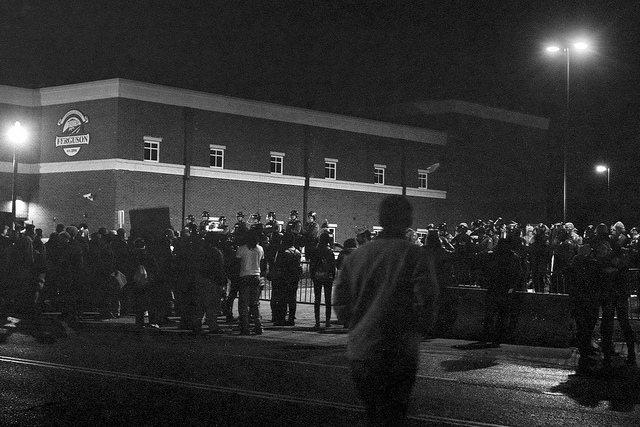Ferguson One Year Later: What’s truly changed?
What were you doing this time last year? In Ferguson, Missouri a 279-pound, 18-year-old college student lay dead in the street. His black body had been shot at least six times and his death became a reawakening to what many black Americans have been saying for generations.
Police brutality is more prevalent in communities of color, and sometimes it’s deadly.
This old adage caught renewed life in the past year since Michael Brown was killed. I don’t know if it’s because technology has allowed us to capture and share images such as Eric Garner gasping: “I can’t breathe” or Walter Scott’s back straighten as he was struck by an officer’s bullets. These are things you cannot unsee.

Protests in front of the Ferguson Police Department a few days after the grand jury chose not to indict then-officer Darren Wilson in Michael Brown’s death. Photo by Mike Tigas.
Or maybe technology affected the growing movement in that social media has made it possible for people from far flung communities to say it happened here in Baltimore, it happened here in Beavercreek, Ohio, it happened here in Cleveland, Ohio, in Milwaukee, in Phoenix, in Pasco, Washington and more.
I don’t know, it could be the plethora of hashtags, or the string of dead bodies, but there has been a shift in America’s consciousness when it comes to race relations and police force. I believe the conversation has changed for the better in that it seems white America believes us more than before. But our country needs more than just talk.
I went to college at the University of Missouri in Columbia, which is two hours from St. Louis. Naturally a slew of folks from the ‘Lou went to Mizzou and most of my besties are from there or live nearby. To most of the world Michael Brown died in Ferguson, but to my friends and others, it’s all St. Louis.
I remember hearing their stories in the days, weeks and months after Brown was killed. The shock after his death. The tanks and tear gas that rolled down the street. The real fear families felt was heartbreaking. From a 9-year-old boy crying because he worried he would be killed by a police officer some day, to Facebook updates chronicling how teargas felt, to an elderly woman who barricaded herself in her home, stockpiling canned goods in case there were more riots.
So now, it’s a year later and what’s changed? After a damning Justice Department investigation found a pattern of civil rights violations in Ferguson, the city has switched out some of its government officials, but what else?
I asked my friends and many agreed the overt police discrimination has decreased, but there’s still the institutional problems of economic inequality and access to quality education. And those systemic problems take time and long-term commitment to fix.
Unfortunately in some ways there is more division between blacks and whites since that warm Saturday last August when Brown was killed.
“People either support the cops or black lives, never both,” said a mom of two. “I think it is sad that despite all of these murders of unarmed citizens, nothing is really being done.”
Another friend talked about feeling frustrated about “the shooting of black people by police and by our own community nightly. How do you get through to either? How do we break the ignorance? Be it our white community saying ‘just comply regardless of your rights.’ Those who insist on stating ‘All Lives Matter’ in an attempt to counter ‘BlackLiveMatter.’ It’s disrespectful. To assume we don’t care about police lives, white lives, or animal lives. We do! But Black lives are on the chopping board. Asking for your right to live (and) to be respected is not a call to devalue others’ lives.”
Still, it hasn’t all been bad.
“The political awareness and community activism that has taken (place) is remarkable,” said one friend who was on the front lines in Ferguson. “Awareness of the inequalities modeled in Ferguson has risen, yet we have a long way to go in terms of addressing those inequalities in any way that will reform this community at the root.”
He also was inspired by the local students who began to fight for change in their community.
“(My) proudest moment is seeing how particularly young people have taken the mantle of action,” he said. “From high school students across the city staging walk outs to leaders of United We Fight, Organization of Black Struggle, Hands Up United and Black Lives Matter providing leadership training, community forums and programs that engage our community to take more action.”
We all agree we’ve got a ways to go. I know there’s going to be more black bodies in the streets at the hands of each other and of law enforcement, but enough is enough is enough. I hope 2014 marks the beginning of long-lasting change in race relations.
I feel like I keep saying that on this blog. I keep hoping for a better America, the one that truly has “liberty and justice for all.”
I know it’ll take more than hope, it’ll take action. My power is in my pen. Have you found your power?

As always my friend your words are motivating as well as oddly comforting. It’s great to read something from someone I admire as well and trust
that is written openly and honestly. You are
blessed with a comforting bluntness and honesty.bloge that about you! The dialogue is open my friend!
Dang Katy! I’ve never had my bluntness called “comforting,” that’s a huge compliment and I thank you for that. I’m glad you appreciate it because it’s the only way I know how to be. It’s certainly gotten me in hot water over the years, but thankfully people generally know where they stand with me, which makes life easier. 🙂 Miss you Helena Christensen!!